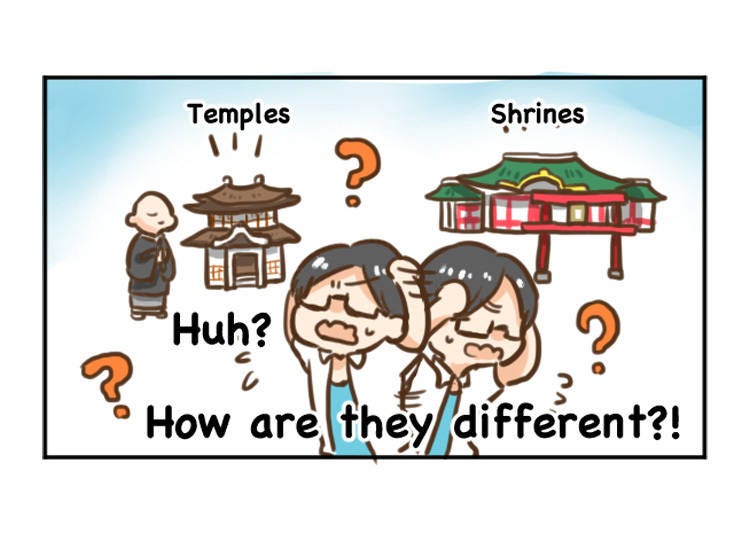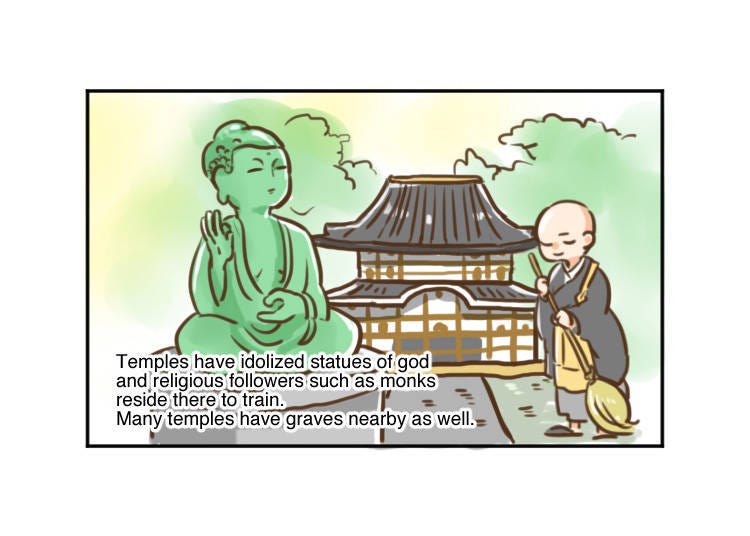
Temples and shrines are iconic symbols of Japanese culture, but each serves a distinct purpose and embodies different religious traditions. Understanding their unique characteristics can enrich your experience when visiting these sacred sites. Here’s a closer look at what sets them apart.
- Table of Contents
Key Differences Between Temples and Shrines

The previous scenario is surprisingly common. Although the ambiance at both is similar in nature, shrines and temples are actually completely different facilities.
1. Religious Affiliation

To put it simply, the religious affiliation for each is different.
Temples (tera or -ji): These are places of worship for Buddhism, a religion that arrived in Japan from China and Korea. Temples often focus on Buddhist practices aimed at personal enlightenment and liberation from suffering.

Shrines (jinja): Shrines are dedicated to Shinto, Japan’s indigenous religion, which centers around reverence for nature, ancestors, and life events.
2. Architectural Features

- Known for their curved roofs, decorative tiles, and symmetrical designs that represent the harmony and balance of Buddhist beliefs.
- Visitors often enter through a sanmon gate, a grand gate symbolic of Buddhist teachings.
- Temples typically have large incense burners at the entrance, where visitors cleanse themselves before entering.
- Many temples include graveyards on their grounds, as they are associated with ancestral worship and funerary rituals.
- Marked by torii gates, which signify the entrance to sacred Shinto grounds. These gates are often painted vermilion red, representing protection and purification.
- Shrines have a simpler, more naturalistic design than temples and are often harmoniously integrated with surrounding nature, as Shintoism emphasizes the worship of natural elements.
- Near the entrance, shrines feature a tezumisha, or purification area, where visitors wash their hands and mouths to cleanse themselves before approaching the shrine.
3. Worship Practices
In Buddhist temples, worshippers usually pray silently with hands clasped in front of their chest, fostering an atmosphere of inner reflection. The primary focus of Buddhist temple practices is on achieving inner peace, personal enlightenment, and freedom from suffering. These practices emphasize a meditative, introspective approach, guiding followers toward self-discovery and spiritual growth.
In contrast, Shinto shrines involve a more interactive ritual to engage with the kami, or gods. Worshippers follow a specific pattern: bowing twice, clapping twice to attract the kami's attention, and then bowing once more. Shinto practices are often linked to celebrating life events, seasonal festivals, and nature's beauty, highlighting a joyful reverence for the natural world and its cycles.
4. Enshrined Objects
Buddhist temples often enshrine statues representing various Buddhas, bodhisattvas, and deities. These statues serve as focal points for worship and are usually displayed openly, allowing visitors to see them and pay their respects. This openness reflects the Buddhist emphasis on accessibility and connection with representations of enlightened beings as a way to inspire and guide followers on their spiritual paths.
In contrast, Shinto shrines enshrine sacred objects called go-shintai, believed to house the spirit of the kami. Unlike Buddhist statues, these objects are usually kept hidden from public view to preserve their sanctity and maintain a sense of mystery. This practice reflects the Shinto focus on purity and reverence, ensuring that the presence of the kami remains both respected and somewhat enigmatic, reinforcing the shrine's role as a sacred space.
5. Religious Personnel
Buddhist temples are overseen by monks, known as obosan, who are responsible for conducting daily rituals, leading prayers, and maintaining the temple grounds. These monks play a central role in guiding temple activities and supporting the spiritual needs of visitors, helping to preserve the traditions and teachings of Buddhism within the temple setting.
Shinto shrines, on the other hand, are maintained by priests called kannushi, who are often assisted by shrine maidens, or miko. The priests perform various shrine rituals, while the miko may conduct ceremonial dances and assist with other sacred tasks. Together, they uphold Shinto practices, celebrating festivals and life events, and helping worshippers connect with the kami through ritual and tradition.
A Blended Heritage

While these distinctions are important, it’s also interesting to note that many Japanese people visit both temples and shrines for different reasons.
They may visit shrines for life celebrations, seasonal festivals, or New Year blessings, and turn to temples for prayers for the deceased, personal reflection, or to seek peace and guidance. Over time, Buddhism and Shintoism have intertwined in Japan, creating a unique cultural blend where elements of both religions sometimes coexist at the same site.
Knowing the differences between temples and shrines not only enhances your cultural experience but also deepens your understanding of Japan’s spiritual landscape. So on your next visit, you’ll be equipped to recognize the beauty and significance of these sacred spaces. Enjoy exploring with your new knowledge!
Illustrations by Manga de Japan
- Category
*Prices and options mentioned are subject to change.
*Unless stated otherwise, all prices include tax.
Popular Tours & Activitiess
Recommended places for you
-

ISHIDAYA Hanare
Yakiniku
Kobe, Sannomiya, Kitano
-
Goods

Yoshida Gennojo-Roho Kyoto Buddhist Altars
Gift Shops
Nijo Castle, Kyoto Imperial Palace
-

Jukuseiniku-to Namamottsuarera Nikubaru Italian Nikutaria Sannomiya
Izakaya
Kobe, Sannomiya, Kitano
-

Kambei Sannomiyahonten
Yakiniku
Kobe, Sannomiya, Kitano
-

Kanzenkoshitsuyakinikutabehodai Gyugyu Paradise Sannomiya
Yakiniku
Kobe, Sannomiya, Kitano
-
Appealing

Rukku and Uohei
Izakaya
Sapporo / Chitose
-

Enjoy Japan's Gorgeous Winter Lights! Ride the Romancecar to Shonan no Hoseki Illumination
by: Guest Contributor
-

How to Get Don Quijote's Exclusive 2025-2026 Winter Gift (+Tax-Free Savings)
-

Tokyo City Pass Upgrade: Harry Potter Studio Tour & Top Sights up to 85% Off
by: Guest Contributor
-

A Travel Game Changer! Go Hands-Free Between Tokyo and Kyoto with LUGGAGE EXPRESS by JTB and JR Tokai
by: Guest Contributor
-

[Extended Offer!](12% OFF KKday Coupon) Mt. Fuji Autumn Leaves, Powder Snow & More! 15 Best Tours to Experience Japan in Fall & Winter
-

Simply Oishii Wagashi School Discover Japanese Culture Through Wagashi: A Hands-On Experience!
by: Guest Contributor
-

5 Popular Shops and Gift Ideas Along Arashiyama Shopping Street
-

Hakodate 2-Day Itinerary for Exploring Japan's Foodie North!
-

Meiji Shrine (Meiji Jingu): Exploring the Sacred Sanctuary of Peace in Bustling Tokyo
-

5 Must-Visit Nara Temples and Shrines: Discover the Timeless Beauty of Japan's Ancient Capital
by: WESTPLAN
-

Niigata Bucket List: 26 Best Things to Do in Niigata Prefecture For Tourists (Attractions, Local Foods & Activities)
-

Kiyomizu-dera Temple: Guide to Visiting Kyoto's Most Famous Sightseeing Spot
- #best sushi japan
- #what to do in odaiba
- #what to bring to japan
- #new years in tokyo
- #best ramen japan
- #what to buy in ameyoko
- #japanese nail trends
- #things to do japan
- #onsen tattoo friendly tokyo
- #daiso
- #best coffee japan
- #best japanese soft drinks
- #best yakiniku japan
- #japanese fashion culture
- #japanese convenience store snacks

















